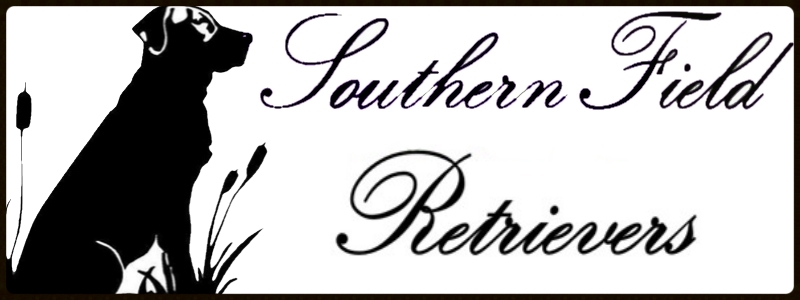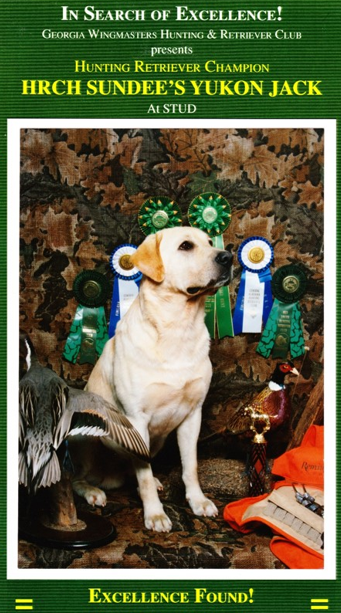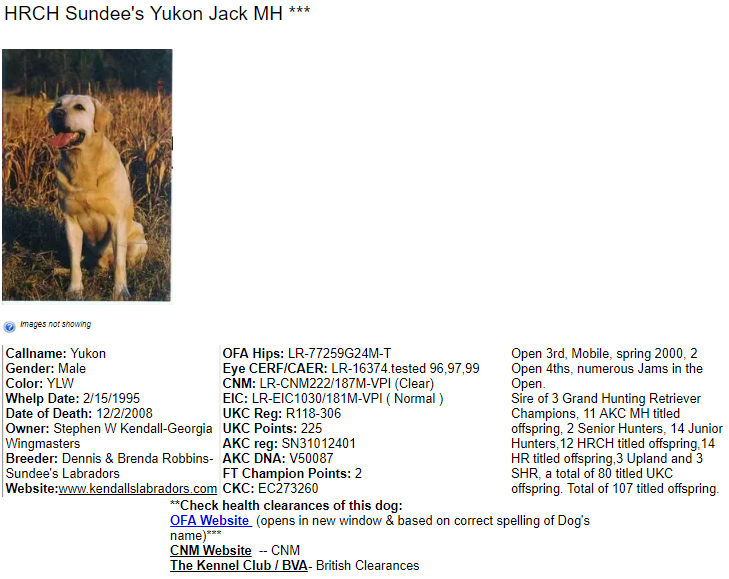HRCH SUNDEE'S YUKON JACK MH
Open 3rd, Mobile, spring 2000, 2 Open 4ths, numerous Jams in the Open.
Sire of 3 Grand Hunting Retriever Champions, 11 AKC MH titled offspring, 2 Senior Hunters, 14 Junior Hunters,12 HRCH titled offspring,14 HR titled offspring,3 Upland and 3 SHR, a total of 80 titled UKC offspring. Total of 107 titled offspring.
HRCH Sundee’s Yukon Jack MH 02/15/1995 – 12/02/2008
Was OAA, beating Lean Mack in his first Open, Duluth Minn. One of the most outstanding sires of gundogs during his life time. With 107 titled offspring to include 3 Grand Champion offspring, 11 MH titled offspring and 13 HRCH titles offspring, his grand offspring also including great dogs such as Rankin, a GRHRCH, SRS& QAA, 4X GRHRCH Big Black Dude 11. Yukon’s pups are proven winners in trial or the hunt and demonstrates incredible drive and trainability along with the sagacity it takes to learn quickly. Yukon’s confirmation, block head and massive chest are the reflected in his offspring as well. He was a once in a lifetime gift, and a limited quantity of frozen semen is available to approved females.
For stud information contact Stephen Kendall www.kendalllabradors.com
Breeding Better Dogs:
Around the turn of the century, Jean O’Connor, Hat Creek Retrievers, started a breeding program of Labrador Retrievers. Jean, like me, had a soft spot for Yellow Labrador Retrievers. So, a breeding program using my male, Sundee’s Yukon Jack began with her females.
Today, 17 years later, I am pleased to report that the program has been very successful. Jeans females, when crossed with Yukon produced not only high drive, intelligent offspring but also as close to disease free as is possible and yet still maintained that wonderful “Big Dog” conformation. WE DID IT!!!
How did she do it, well we “ LINE BREED” on Yukon. That said, line breeding in the world of Labrador Retrievers that are bred to hunt over and/or play ribbon chasing field events has been sort of a No, No. Rarely do you ever see a breeding or litter that focuses on genetics, moreover the breeding is primarily based on Titles to Titles breeding without regard to certain lines. I take exception to this kind of breeding, its proven to be ineffective. The reason is due to what I have learned from canine genetic experts and breeders like Dennis Robbins and Bob Wehle, the famous founder of the Elhew line of pointers. I read his book, SNAKEFOOT, The making of a Champion. He “Line Breed”, he was also a geneticist. Now, he did it much deeper of course than what we do today with Labs but still when you talk to the experts, it’s a common fact that “LINE BREEDING” produces more consistency in the offspring, the good, the bad and the ugly, so its extremely important you pick a great dog that has the right balance.
The formula we use was based on a recommendation by a solid breeder of Bench Bred labradors. She told me to pick one “special dog” aka a Matador Sire of the line. This is what we have done.
When Chief came of age Jean jumped right in and bred to him and has done so since that first breeding. The results have been awesome but probably the best mating to date, or perhaps the most proven mating to date is the Chief x Josey litters. This genetic make up Lines up on Yukon very well, note his position in the pedigree. http://www.huntinglabpedigree.com/pedigree.asp?id=79832
The Wrights Coefficient of inbreeding for
Yukons Outlaw Of Josey Wales is 14.4%
This is important, most modern day field trial titles to titles breeding are 4 to 6%. Notice that this is 10 generations and also make note the key ancestor in Chief is NFC Super Chief. This is probably the primary ancestor of most all modern day field trial bred Labrador Retrievers.
What is the average COI, what is good and what is not. Well, a COI of only 6% is primarily an “OUTCROSS”. CONSEQUENTLY CONSISTENCY IS NOT A VIRTUE IN THESE BREEDINGS. That is one reason you see so many different temperaments, trainability and conformation are hit or miss. What diseases the dogs may carry is unknown.
Good breeders that have been breeding Labrador Retrievers for the field will average around 10% to 12% COI so that’s about the average.
Do we need to outcross, yes, we do and to that end I searched for a nice male which David Brown bought and when he comes of age, he will breed him to a couple of his females. Just remember, when we do an outcross we bring unknown factors into the gene pool, I hope I have chosen wisely. Offspring of this mating could be bred back into Yukon Lines. To assure us of consistency. When I chose this male I carefully examined all of his attributs, Credentials of his sire and dam, conformation and disease were all accessed as well as the background of the stud dogs breeder.
Inbreeding – using COIs
What is inbreeding and how can it impact health?
Inbreeding, put simply, is the mating of related individuals – those individuals with common ancestors. High levels of inbreeding can impact the health of individual dogs, as it increases the chances of a dog being at risk for both known and unknown inherited disorders. It could also have an impact on the breed as a whole, for example, a reduction in litter size and fertility.
How can you measure the degree of inbreeding?
The degree of inbreeding can be measured by using a Coefficient of Inbreeding (COI). This is the probability that two copies of the same variant at a gene have been inherited from an ancestor common to both the sire and dam. The lower the degree of inbreeding, the lower the inbreeding coefficient.
Inbreeding Coefficient Calculators
- Each breed
How many generations of pedigree information are used to calculate the COI? The Huntinglabpedigree website uses 10 Generations.
Putting your dog’s COI result into perspective
The COI calculator provides you with a percentage score; the lower the percentage, the lower the degree of inbreeding.
Therefore, an inbreeding coefficient of:
- 0% indicates a dog that comes from two apparently unrelated parents, based on all available pedigree information
- 12.5% would be the genetic equivalent of a dog produced from a grandfather to granddaughter mating, or the mating of a half-brother/sister
- 25% would be the genetic equivalent of a dog produced from a father to daughter mating, or the mating of full-brother/sister
Inbreeding is accumulative, so if it has occurred to a significant degree over several generations, the inbreeding coefficient may exceed 25%.
Now, the way we have bred is known as, “LINE BREEDING” not inbreeding as described above. In most of the litters you will see Yukon lined up as a grandfather and as a great grandfather, in a couple he was also a great, great grandfather. This type of breeding is our secret to success and I therefore pass it down to you folks.
Best Regards,
Stephen W. Kendall
Kendalls Labradors



